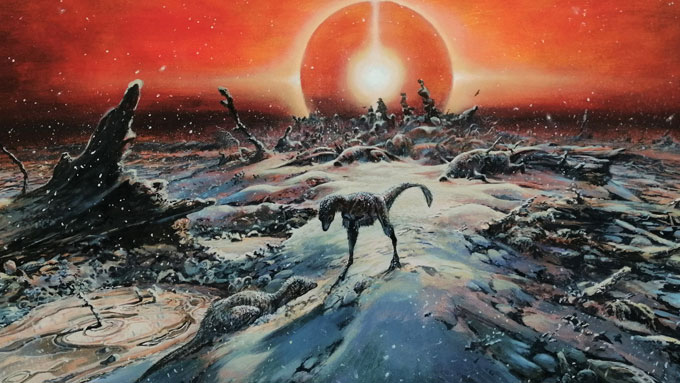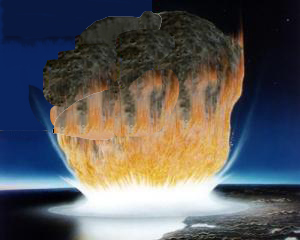Mass Extinction Event Caused by Impact Event
One of the greatest controversies surrounding the Dinosauria is what actually caused the demise of the non-avian dinosaurs? Around the end-Cretaceous mass extinction event, there was an enormous extra-terrestrial impact in the Gulf of Mexico. A worldwide layer of clay, saturated in the rare Earth element iridium, marking the K-Pg geological boundary was first publicised by American father and son Luis and Walter Alvarez. They postulated that an Earth impact event had resulted in this deposition and it was speculated that such a catastrophic event might have been responsible for the extinction of the dinosaurs.
New Study Suggests Dinosaur Extinction Due to the Extra-terrestrial Impact Event
Picture credit: NASA
The “Smoking Gun” Evidence
Such an impact would have left an enormous crater, the search was on to find the “smoking gun” to support the theory regarding a meteorite, asteroid or perhaps a comet hitting the Earth. Most researchers now agree, that the Yucatan peninsula in the Gulf of Mexico was ground zero. However, there is a problem, as scientists are aware of a number of other potential candidates responsible for the extinction of a large amount of the planet’s biota some sixty-six million years ago. For example, the Late Cretaceous was characterised by extensive volcanism.
Huge amounts of lava from the Deccan traps led to the formation of thousands of miles of flood basalt. The out-pouring of noxious gases as a result of this extensive volcanism could well have played a significant role in the extinction of many different kinds of organisms too.
Asteroid impact theory challenged: Blame the Deccan Traps.
In a new paper, a team of international researchers led by Dr Celli Hull from Yale University, conclude that the volcanism did not play a huge role in the extinction, but it may have played a significant role in shaping the rise of different species after the extinction event had occurred.
Impact Event the Most Likely Cause of End-Cretaceous Mass Extinction

Picture credit: James McKay
Analysis of Ancient Ocean Sediments
In order to disentangle the relative effects of the volcanism and the impact event, the scientists analysed deep sea sediment sections drilled from the North Atlantic, Pacific and South Atlantic Oceans. They found that volcanic activity in the Late Cretaceous period caused only a gradual global warming of about two degrees Celsius, but this had no significant effect on marine ecosystems, and cooler conditions had returned prior to the extinction.
Hull et al investigated the timing of the Deccan outgassing by modelling in several scenarios, the effects of the gases ejected by volcanoes (sulphur and carbon dioxide). Their results suggest that more than half of the total Deccan outgassing occurred well before the impact event, not just before it. The scientists concluded that the timing of most of the atmospheric pollution from the extensive volcanism, just did not fit the extinction event. The major volcanism is likely to have occurred at least 200,000 years before the extinction event.
One of the co-authors of the study, Professor Paul Bown (University College London), explained.
“Most scientists acknowledge that the last, and best-known, mass extinction event occurred after a large asteroid slammed into Earth 66 million years ago, but some researchers suggested volcanic activity might have played a big role too and we’ve shown that is not the case.”
The team’s models showed that the changes in the carbon cycle that resulted from the volcanism was mitigated by the oceans absorbing vast quantities of CO2. This would have limited any global warming.
Fellow co-author Professor Paul Wilson (Southampton University), added:
“There’s been a big row about the cause of the mass extinction for decades. The demise of the dinosaurs was the iconic event but they were large animals and there weren’t really that many of them so it’s tough to use them to figure out the cause.”
Professor Wilson added:
“We studied microscopic marine organisms called foraminifera and there are thousands of them in a teaspoon-full of ocean sediment. To get them we drilled into the sea bed in waters nearly 5 kilometres deep not far from the watery grave of RMS Titanic off the coast of Newfoundland using a sort of geology time machine – a drill ship called the JOIDES Resolution run by one the world’s most successful international scientific collaborations, the International Ocean Discovery Program.”
The authors postulate that the volcanism may have played a role in shaping the evolution of Palaeogene species in the aftermath of the end-Cretaceous extinction event.
What About Hell Creek – Were Dinosaurs Already in Decline?
From a scientific perspective, it makes much more sense to examine the fossil record of planktonic foraminifera. Relying on the non-avian dinosaurs as an indicator of palaeo-climate change some sixty-six million years ago is fraught with difficulties. For instance, although many different types of life were affected by the end-Cretaceous extinction event, it is often only the dinosaurs that are mentioned by the media. It is worth remembering that many other lifeforms died out.
There are not that many windows into the end of the Maastrichtian and the earliest part of the Palaeocene (Danian faunal stage). One such example is the Hell Creek Formation, which provides a record of the last few million years of the Mesozoic.
Studies of the number and variety of dinosaur fossils excavated from the Hell Creek Formation and other slightly older geological formations, suggest that in the last ten million years of the Cretaceous, the number of dinosaur species fell by more than fifty percent.
An analysis of the youngest fifteen metres of sediments from the Hell Creek Formation, revealed just eleven different types of dinosaur. In the uppermost strata, the last three metres of the Hell Creek Formation representing the end of the Cretaceous, only three types of dinosaur were recorded.
Difficulties in Dating Strata
Whilst it can be difficult to accurately date and assess the chronology of strata, the study of dinosaur fossils from Hell Creek suggests that the Dinosauria may have been in decline (at least in this part of Laramida), prior to the impact event. This decline, if it was a decline, could have been caused by the environmental effects of the extensive volcanism, or other factors for that matter.
We suspect that just like the Deccan Traps, this debate is going to rumble on for a considerable period of time.
The Everything Dinosaur website: Everything Dinosaur.







It would be really nice if you included a reference for the papers you discuss. If you have, I can’t find it.
The paper was published in “Science” the journal of the American Association for the Advancement of Science it is entitled: “On impact and volcanism across the Cretaceous-Paleogene boundary” you can subscribe to the article at this link.